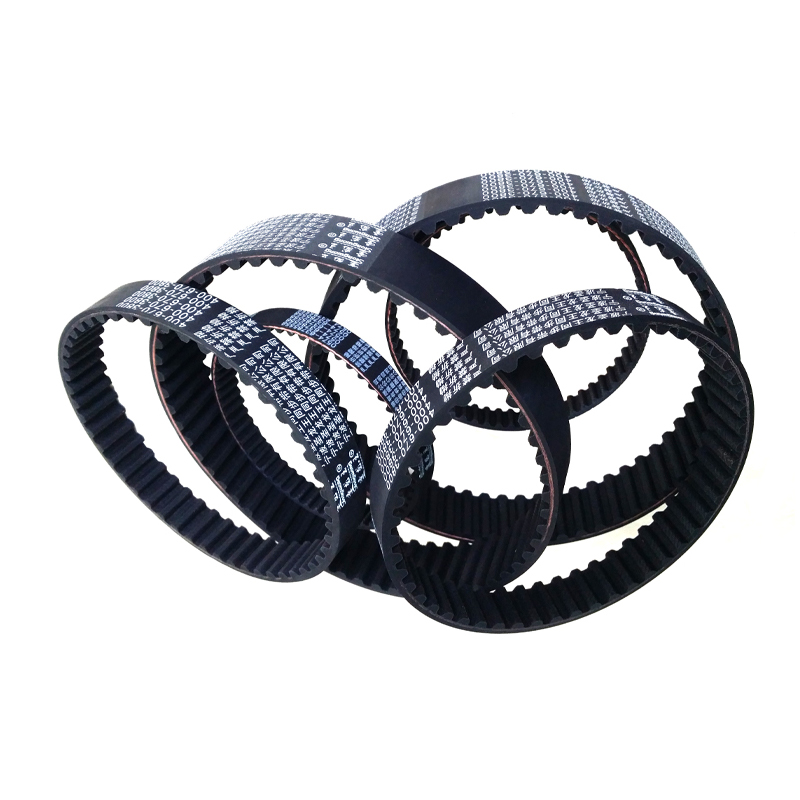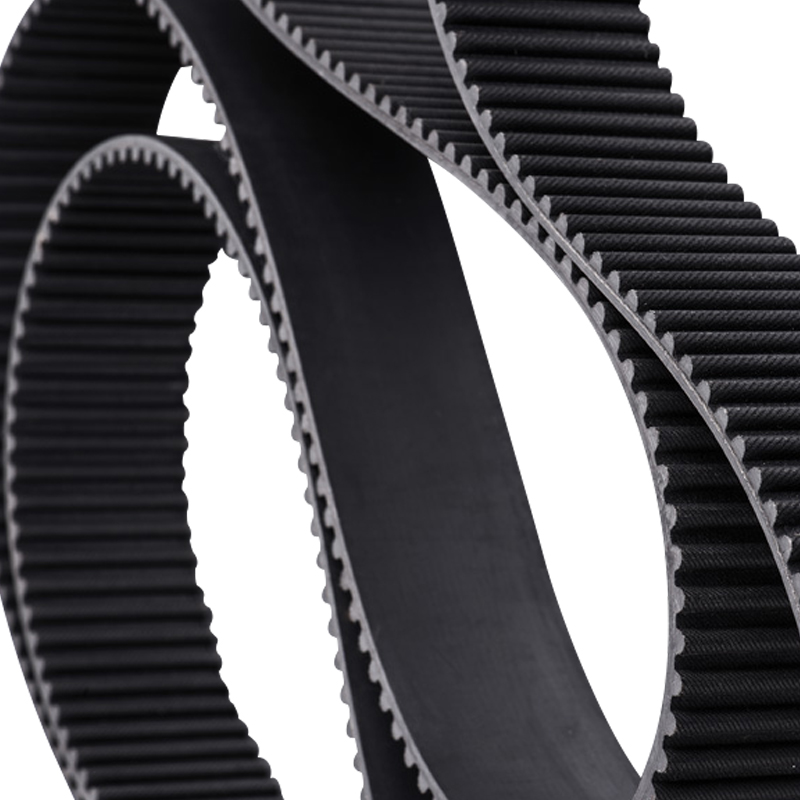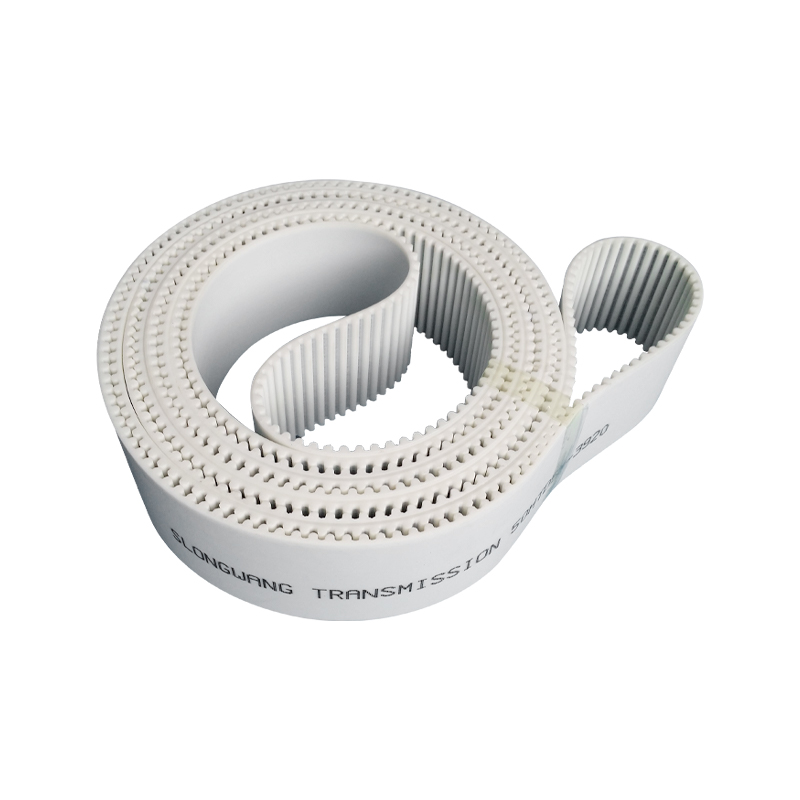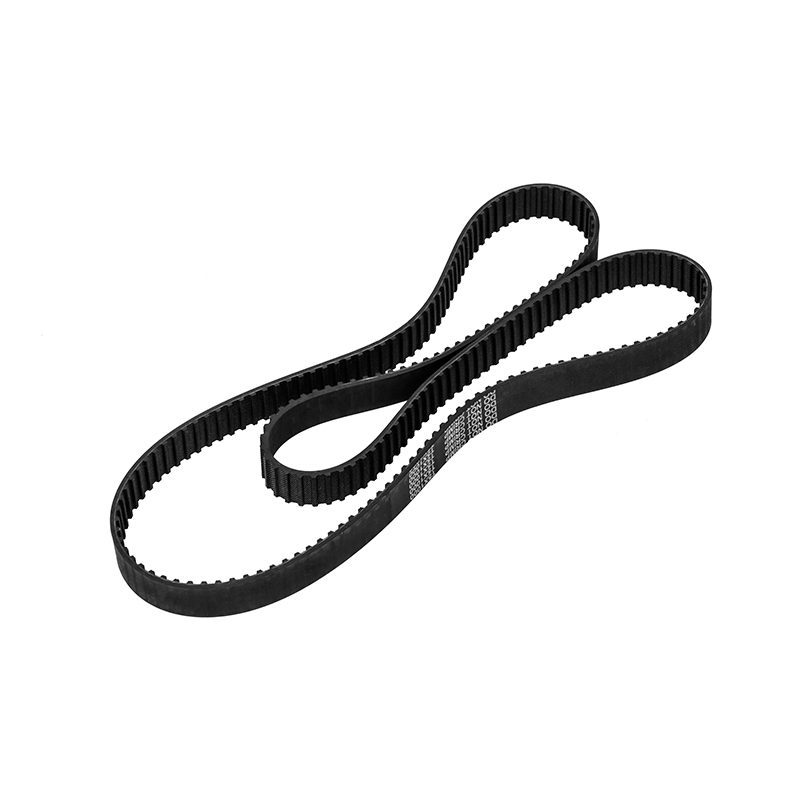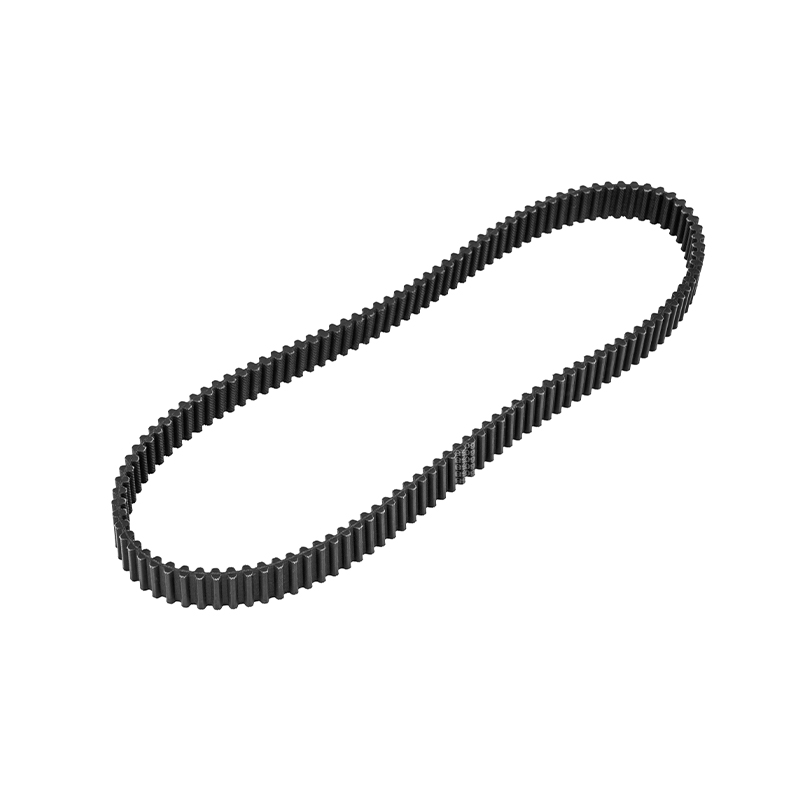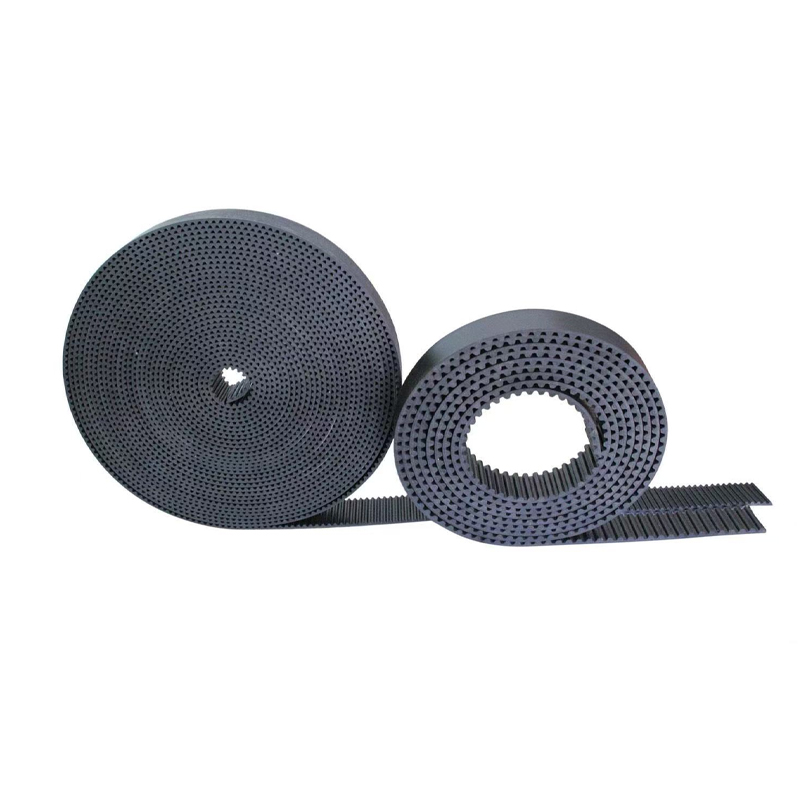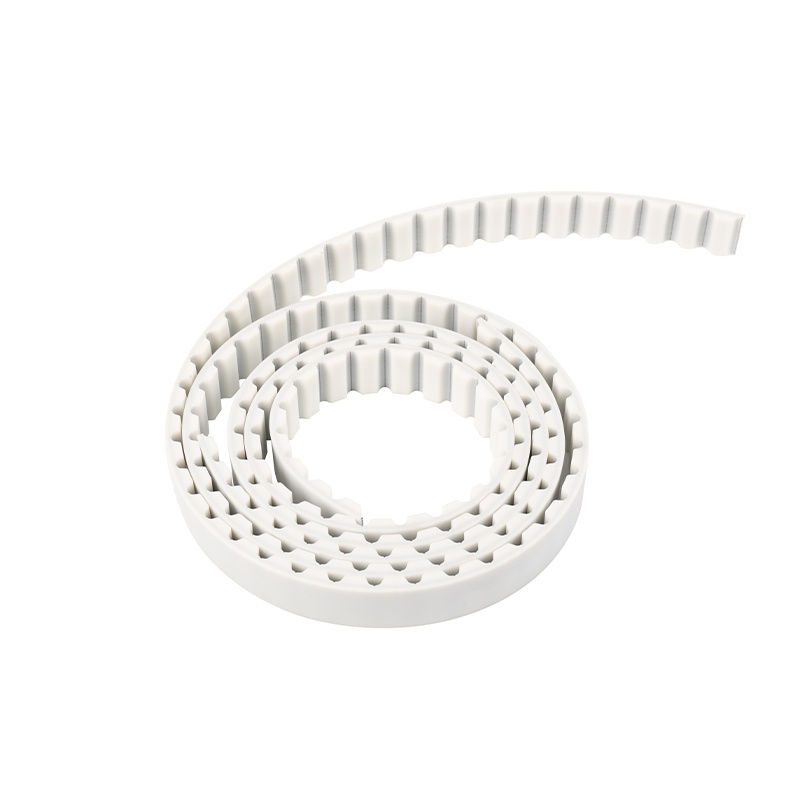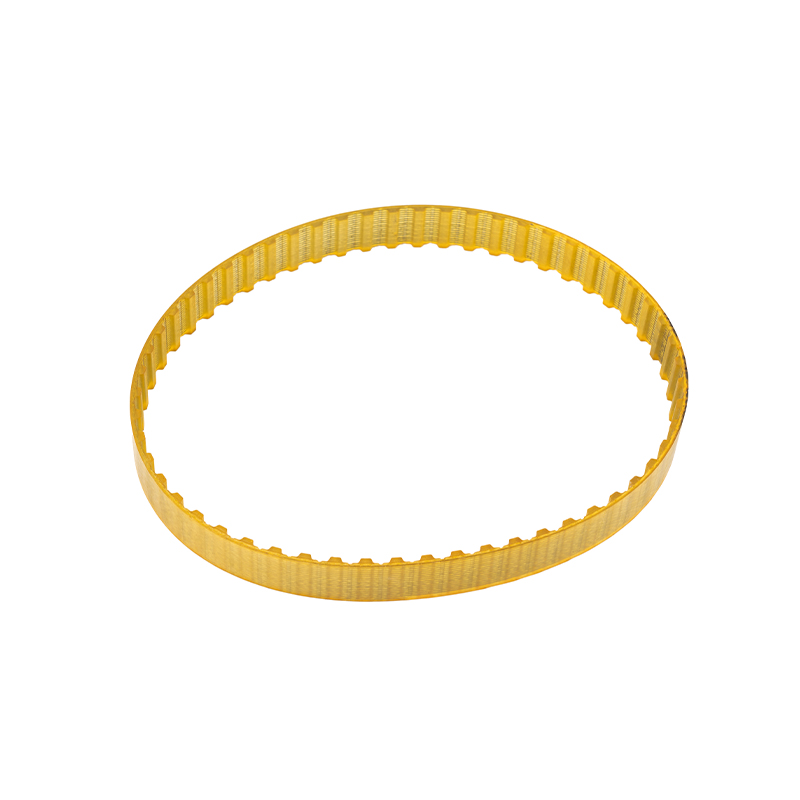Why PU timing belts are becoming more and more popular in the industrial field
2025-08-13
Content
- 1 Definition and Basic Characteristics of PU Timing Belts: From Materials to Structure
- 2 Outstanding Wear Resistance: How Do PU Timing Belts Improve the Durability of Mechanical Equipment?
- 2.1 The Natural Advantages of Polyurethane Materials
- 2.2 Incorporation of Reinforced Fibers: Improving Durability
- 2.3 Optimizing the Coefficient of Friction: Reducing Wear
- 2.4 Excellent Aging Resistance: Extending Service Life
- 2.5 Reducing Equipment Failures: Improving Production Line Stability
- 2.6 Adaptability to Harsh Environments: Performance under High Temperatures and High Loads
- 3 High Performance and Low Energy Consumption: PU Timing Belts Help Industrial Energy Conservation and Emission Reduction
- 3.1 Low Friction and High Transmission Efficiency: Reducing Energy Loss
- 3.2 Reducing Load and Power Requirements
- 3.3 Reduced Heat Generation: Reduced Cooling Requirements
- 3.4 Extended Service Life: Reduced Replacement Frequency and Resource Consumption
- 3.5 Wide Application: From Precision Equipment to Heavy Machinery
- 3.6 Environmental Advantages: Low Noise and Recyclability
- 4 Low Maintenance Cost: How Do PU Timing Belts Reduce Equipment Maintenance Needs?
- 4.1 Reducing the Need for Frequent Belt Replacement
- 4.2 Reducing Downtime and Production Interruptions
- 4.3 Improve Equipment Operational Stability and Reduce Failure Rates
- 4.4 Reduced Labor and Maintenance Costs
- 4.5 Reducing Unnecessary Part Replacement and Repair
- 4.6 Simplify Maintenance and Reduce Maintenance Complexity
- 5 Precision Transmission: Advantages of PU Timing Belts for High-Precision Requirements
- 6 Multi-Field Applications: Widespread Use of PU Timing Belts in the Automotive, Food, and Automation Industries
Definition and Basic Characteristics of PU Timing Belts: From Materials to Structure
With the continuous advancement of industrial technology and the increasing degree of automation, the demand for transmission systems is gradually shifting towards high precision, high efficiency, and low maintenance. Against this backdrop, polyurethane (PU) timing belts, as a key transmission component, are gaining increasing popularity across multiple industrial sectors due to their unique advantages.
Basic Definition of PU Timing Belts
As the name suggests, PU timing belts are made of polyurethane. They feature a precise tooth profile and are widely used in mechanical systems requiring high-precision transmission. Unlike ordinary belts, PU timing belts utilize a gear structure that precisely meshes with the tooth grooves, enabling precise transmission without slippage or tooth sliding. Therefore, PU timing belts offer extremely high transmission efficiency and are particularly suitable for applications requiring high speed control and transmission stability.
PU timing belts are primarily composed of polyurethane (PU) material and a high-strength fiber reinforcement layer. As a synthetic material with excellent properties, polyurethane provides excellent elasticity and wear resistance while ensuring belt strength. The fiber reinforcement layer ensures the timing belt maintains sufficient strength and tensile strength even under high-load operation.
|
Features |
PU timing belt |
Traditional belts (such as rubber timing belts) |
|
Material |
Polyurethane (PU) |
Rubber (such as neoprene, EPDM, etc.) |
|
wear resistance |
High, with excellent anti-wear and anti-aging capabilities |
Low, prone to performance degradation due to wear or aging |
|
Heat resistance |
Strong adaptability to high and low temperatures, suitable for working environments ranging from -30°C to +80°C |
The temperature adaptability is poor and it is often used in the low and medium temperature range. |
|
Chemical resistance |
Good resistance to corrosion by most oils, acids, alkalis and other chemicals |
Poor, easily corroded by oil and chemical solvents |
|
Accuracy |
High, with precise tooth design to avoid slippage and ensure high transmission accuracy |
Poor precision, easily affected by looseness or slippage, which may affect transmission performance |
|
UV resistance |
Excellent resistance to UV rays and ozone |
Poor, easy to age if exposed to sunlight for a long time |
|
Noise and vibration |
Low noise and low vibration, suitable for precision equipment and automated production |
Noisy and vibrating, suitable for heavy load and low speed applications |
|
Service life |
Long, wear-resistant, aging-resistant and corrosion-resistant, long service life |
Shorter, requiring frequent replacement and maintenance |
|
Load bearing capacity |
High, can bear large load and stable |
Low, prone to deformation or breakage under high load |
|
Maintenance requirements |
Low, strong durability, reducing replacement frequency and maintenance costs |
High, frequent inspection, adjustment and replacement |
|
Cost |
Relatively high, but due to the longer service life and less maintenance requirements, the overall cost is lower |
Low, but due to frequent replacement and maintenance, the overall cost is higher |
Material Advantages: The Excellent Properties of Polyurethane
Polyurethane (PU), the base material for timing belts, possesses numerous excellent physical properties. PU boasts exceptionally high wear resistance and tensile strength, maintaining its original shape and performance over extended periods of operation. Compared to traditional rubber materials, polyurethane offers superior wear resistance and can withstand harsh operating environments, particularly under conditions of high loads, high speeds, and high temperatures.
PU material exhibits strong chemical stability. It exhibits strong resistance to chemicals such as oils, solvents, acids, and alkalis, making it widely used in specialized industries. For example, equipment in the automotive, chemical, and food processing industries often faces challenges such as oil contamination and acid-base corrosion. PU timing belts, with their excellent chemical resistance, maintain long-term stability under these conditions.
PU timing belts also demonstrate outstanding environmental adaptability. They can operate stably in extreme environments, such as high and low temperatures, and in humidity, without easily deforming or degrading. This is crucial for many industrial production processes. For example, in cold storage and refrigeration equipment, PU synchronous belts ensure efficient and stable operation of the transmission system even in low-temperature environments.
Structural Design: Precision Transmission Tooth Profile and Reinforcement Layer
Another major advantage of PU synchronous belts lies in their precise tooth profile design. The teeth utilize a unique trapezoidal or circular design, allowing for perfect engagement between the teeth and the grooves, resulting in precise, slip-free transmission. This design not only improves transmission efficiency but also reduces wear and vibration, enhancing system stability. Compared to traditional V-belts, PU synchronous belts offer higher transmission efficiency and are more stable over time.
The structure of a synchronous belt typically consists of a belt body, teeth, and reinforcement layer. The belt body is the core component of the PU material and is responsible for bearing the overall belt load. The teeth transmit power through precise meshing with the grooves. The reinforcement layer is typically constructed of high-strength materials such as steel wire or aramid fiber to enhance the belt's resistance to tension and fracture. Thanks to this layered structural design, PU timing belts can withstand significant tension while maintaining transmission accuracy, adapting to complex industrial environments and various high-load conditions.
Durability and Efficiency
Due to the high hardness and wear resistance of polyurethane, PU timing belts offer a longer service life than traditional belts. Even under prolonged, high-load conditions, PU timing belts maintain minimal wear and deformation, reducing the need for frequent replacement and maintenance. Reducing equipment downtime and improving production efficiency are crucial in industrial production, and the durability of PU timing belts makes them an ideal transmission solution.
The efficient transmission performance of PU timing belts makes them an excellent choice for many demanding industrial applications. For example, in precision machinery, automated production lines, and robotic systems, PU timing belts provide smooth and precise power transmission, ensuring high efficiency and stability during production.
Outstanding Wear Resistance: How Do PU Timing Belts Improve the Durability of Mechanical Equipment?
With the transformation and upgrading of the global manufacturing industry, companies are increasingly demanding higher standards for production efficiency, equipment reliability, and cost control. As a key component in transmission systems, PU (polyurethane) timing belts are increasingly widely used in the industrial sector due to their excellent wear resistance. Compared to traditional rubber timing belts, PU timing belts offer significant advantages in wear resistance, enabling them to perform exceptionally well under high loads, frequent operation, and harsh environments, significantly enhancing the durability of mechanical equipment.
The Natural Advantages of Polyurethane Materials
The wear resistance of PU timing belts stems primarily from their core material—polyurethane. As a synthetic polymer, polyurethane offers many advantages over rubber, particularly in wear resistance. Polyurethane's molecular structure is more compact than rubber, making it resistant to friction and tearing over extended use. This structure enables PU timing belts to maintain their physical properties and structural stability even under high-speed operation and frequent friction.
The hardness and elasticity of polyurethane materials can be adjusted to meet specific needs. By modifying the polyurethane formulation and processing, the wear resistance of PU timing belts can be further enhanced, enabling them to operate for extended periods in harsher operating environments. This tailored material property makes PU timing belts widely used in various industries, particularly in equipment subject to high mechanical loads and frequent friction.
Incorporation of Reinforced Fibers: Improving Durability
The wear resistance of PU timing belts is also closely related to the reinforcement layer within their structure. Most PU timing belts utilize a layer of reinforced fibers, such as steel wire, aramid fiber, and polyester fiber. The addition of these reinforcing materials significantly improves the belt's tensile strength and fracture resistance. The fiber reinforcement layer not only strengthens the belt itself but also effectively distributes and resists external pressure and impact, minimizing damage caused by overload, impact, or friction.
Reinforced fibers not only increase the belt's load capacity but also enhance its tear resistance. Even under prolonged, high-intensity operation, PU timing belts maintain stable performance, preventing premature failure due to material fatigue. This is particularly important for equipment that requires continuous operation, such as automated production lines, packaging machinery, and textile equipment.
Optimizing the Coefficient of Friction: Reducing Wear
The coefficient of friction of a PU synchronous belt is a key indicator of its wear resistance. The lower the coefficient of friction, the less wear between the material and other components, and the longer the service life of the equipment. The inherently low coefficient of friction of polyurethane means that when transmitting power, the contact surface of the PU synchronous belt with the gears or pulleys experiences relatively little wear, extending the service life of the belt.
The high surface smoothness of polyurethane reduces friction with other metal or plastic components. This allows the PU synchronous belt to maintain a low temperature rise during high-speed operation, further reducing material degradation and wear caused by heat buildup.
Excellent Aging Resistance: Extending Service Life
Besides direct friction and wear, many synchronous belts also experience aging during use. Conventional rubber synchronous belts, exposed to air for a long time, can oxidize and age due to UV radiation, leading to brittleness and a loss of strength, which in turn affects the transmission accuracy and life of the belt. Polyurethane, on the other hand, offers excellent aging resistance, effectively resisting damage from UV rays, oxygen, ozone, and other factors, slowing the aging process.
PU timing belts maintain their elasticity and toughness over extended periods of time, resisting aging even in high or low temperatures or humid environments, ensuring continuous and efficient equipment operation. This resistance to aging makes PU timing belts particularly valuable in industries such as chemicals, food, and pharmaceuticals, where production equipment often operates around the clock.
Reducing Equipment Failures: Improving Production Line Stability
Due to the high wear resistance and long service life of PU timing belts, maintenance frequency for mechanical equipment is significantly reduced, significantly improving production line stability. Traditional timing belts require regular replacement, especially in high-intensity, high-speed environments. Increased wear can lead to equipment failure, impacting production efficiency. PU timing belts, however, offer excellent wear resistance and provide long-term, stable operation, eliminating the need for frequent replacement and repairs.
This not only reduces downtime but also lowers production line operating costs. Increased equipment stability also boosts production efficiency, enabling companies to better respond to fluctuating market demands and shorten production cycles.
Adaptability to Harsh Environments: Performance under High Temperatures and High Loads
In some specialized industrial environments, such as those subject to high or low temperatures, humidity, or oil, traditional timing belts may rapidly wear out or damage due to material defects. However, the high-temperature and corrosion resistance of PU timing belts enables them to operate reliably and continuously in these harsh environments. Polyurethane inherently possesses high heat resistance, maintaining its elasticity and strength even under high temperatures, making it less susceptible to deformation and damage.
For example, in the food processing industry, PU timing belts not only face physical wear and tear but also withstand corrosion from oils and detergents. The chemical resistance of polyurethane timing belts allows them to withstand corrosion from grease, oils, acids, and bases, extending their service life in harsh environments and ensuring stable production line operation.
High Performance and Low Energy Consumption: PU Timing Belts Help Industrial Energy Conservation and Emission Reduction
With the increasing global demand for sustainable development and environmental protection, the industrial sector is pursuing higher production efficiency while also placing increasing emphasis on energy conservation and emission reduction. As a core component of industrial equipment, the energy efficiency of the transmission system directly impacts the energy consumption of the entire production line. PU (polyurethane) timing belts, with their exceptional high performance and low energy consumption, have become a key technology for energy conservation and emission reduction in the industrial sector. Compared to traditional transmission methods, PU timing belts help industrial equipment reduce operating costs and improve energy efficiency by providing precise power transmission, reducing friction loss, and minimizing energy waste.
Low Friction and High Transmission Efficiency: Reducing Energy Loss
The transmission efficiency of PU timing belts is a key factor in their role in energy conservation and emission reduction. Unlike traditional belt drives, their precise tooth meshing ensures virtually no slippage during power transmission, eliminating energy waste. In contrast, traditional V-belts are prone to slippage and friction, which converts some energy into heat, wasting some power.
The tooth profile design of PU synchronous belts ensures smooth operation. The precise meshing between teeth and tooth grooves creates virtually no slippage, significantly improving transmission efficiency. Efficient energy conversion and transmission minimizes power loss, thereby reducing energy consumption. Furthermore, the inherently low coefficient of friction of polyurethane material means that the synchronous belt generates less frictional resistance during operation, further reducing energy loss. Therefore, PU synchronous belts not only improve the efficiency of mechanical equipment but also reduce energy waste.
Reducing Load and Power Requirements
Compared to traditional belt drives, PU synchronous belts are better suited to high-load operating conditions due to their high strength, toughness, and light weight. Their fiber-reinforced layer allows them to withstand greater loads without deformation or breakage, reducing energy consumption under high loads. The high-strength design of the synchronous belts enables more efficient power transmission, making it less susceptible to the loss of power system efficiency caused by excessive loads.
By reducing additional loads and mechanical friction, PU synchronous belts enable industrial equipment to maintain low power consumption even under high-load conditions. This high-efficiency transmission method helps companies reduce equipment power requirements, conserve electricity, and ultimately achieve energy conservation and emission reduction goals.
Reduced Heat Generation: Reduced Cooling Requirements
In many industrial applications, transmission systems operating under high loads and high speeds often generate significant frictional heat. Traditional belt or chain drives generate significant heat under high loads, leading to excessive equipment temperatures, impacting normal operation and even requiring additional cooling systems to control temperature, further increasing energy consumption.
The low friction coefficient of PU timing belts allows them to generate significantly less heat during operation than traditional transmission systems. This not only helps reduce equipment damage and maintenance costs caused by overheating, but also effectively reduces cooling system energy consumption. By reducing heat generation, PU timing belts help industrial equipment maintain higher efficiency and avoid excessive energy waste.
Extended Service Life: Reduced Replacement Frequency and Resource Consumption
The durability and long service life of PU timing belts enable them to maintain efficient transmission performance for longer periods of time. Compared to traditional timing belts, PU timing belts wear more slowly and have a longer service life. This means that equipment can maintain high transmission efficiency even after extended operation, avoiding the resource waste associated with frequent belt replacements.
Frequent drive belt replacement not only increases maintenance costs for businesses but also increases the waste of used belts. The long lifespan of PU timing belts effectively reduces equipment downtime and maintenance costs, while also lowering the environmental impact of resource consumption. By reducing the frequency of belt replacement, businesses can conserve energy while reducing the consumption of natural resources, achieving a greener production model.
Wide Application: From Precision Equipment to Heavy Machinery
PU timing belts are not only suitable for general automation equipment and precision machinery, but are also widely used in heavy machinery, metallurgy, automotive, and aerospace. Equipment in these industries often operates under high loads for extended periods, placing extremely high demands on the drive system. PU timing belts, with their high efficiency and low energy consumption, are well-suited to these demanding operating conditions.
For example, on automotive production lines, PU timing belts connect components such as engines and drive shafts, ensuring smooth operation of the entire production line. Through efficient power transmission, PU timing belts can effectively reduce energy waste, improve production efficiency, and lower energy consumption during the production process. In the metallurgical industry, PU synchronous belts can be used for equipment transmission in high-temperature environments, reducing heat loss and maintaining efficient machinery operation.
Environmental Advantages: Low Noise and Recyclability
PU synchronous belts also offer unique environmental advantages. Compared to traditional belt systems, PU synchronous belts operate at lower noise levels, reducing noise pollution to operators and the surrounding environment. In the context of energy conservation and emission reduction, reducing noise and vibration is crucial for improving the quality of the working environment, and the low noise characteristics of PU synchronous belts precisely meet this need.
Polyurethane material is inherently highly recyclable. Used PU synchronous belts can be recycled and reused through appropriate disposal methods, reducing environmental pollution. This environmentally friendly feature not only makes PU synchronous belts excellent in energy conservation but also reduces resource waste after the production process, further supporting the concept of green industrial development.
Low Maintenance Cost: How Do PU Timing Belts Reduce Equipment Maintenance Needs?
In the daily operation of industrial equipment, maintenance and upkeep are key factors in ensuring smooth production line operation. However, frequent equipment repairs and component replacements often result in high costs, impacting production efficiency and increasing operational pressure. Against this backdrop, PU (polyurethane) timing belts are becoming increasingly popular in the industrial sector due to their significantly lower maintenance costs. Compared to traditional transmission belts, PU timing belts, with their wear resistance, stability, and long-term performance, can significantly reduce equipment repair and maintenance needs, thereby lowering operating costs and improving overall equipment efficiency.
Reducing the Need for Frequent Belt Replacement
After long-term operation, traditional rubber timing belts or belts will gradually wear, crack, or even break due to friction, aging, and external forces, necessitating regular replacement. This need for regular replacement not only increases labor and material costs but also causes production line downtime, impacting production efficiency and delivery times. PU timing belts, with their excellent wear resistance and aging resistance, can maintain their transmission performance for longer, significantly extending their service life.
The molecular structure of polyurethane is denser than that of rubber, making PU timing belts more wear-resistant. Even under high loads and frequent operation, PU timing belts wear much more slowly than traditional materials. This extends equipment maintenance cycles, allowing companies to reduce the frequency of belt replacements, thereby reducing the downtime and costs associated with belt replacements.
Reducing Downtime and Production Interruptions
Equipment downtime directly impacts production efficiency. For many companies, maintenance downtime not only means a temporary interruption in production but also the labor, material, and time required for equipment repairs. Traditional belts and timing belts frequently require repair or replacement due to wear and tear during use. This is particularly true on production lines with high loads and frequent operation.
The high wear resistance and long service life of PU timing belts make equipment failures extremely rare during operation. Even under extreme conditions, PU timing belts can continuously provide stable power transmission, reducing equipment downtime caused by belt damage. By reducing failures caused by belt problems, equipment production cycles become more continuous, maintenance workload is significantly reduced, and companies can save significant repair and downtime costs.
Improve Equipment Operational Stability and Reduce Failure Rates
Another significant advantage of PU timing belts over traditional synchronous belts is their superior operational stability. Traditional belts and timing belts are susceptible to environmental factors, temperature fluctuations, moisture, and chemicals over long periods of operation, leading to a gradual decline in performance. PU timing belts, however, perform exceptionally well in these environments, offering long-term stable operation and reducing equipment failure rates.
The aging, corrosion, and high-temperature resistance of PU timing belts enable them to maintain excellent performance in diverse operating environments. For example, in high-temperature or humid environments, PU timing belts maintain their elasticity and strength, preventing failures caused by aging, deformation, or breakage. This stability ensures continuous and efficient equipment operation over extended periods, reducing the need for extensive repairs due to equipment failures and significantly reducing maintenance costs.
Reduced Labor and Maintenance Costs
Traditional timing belts frequently experience damage and wear, requiring regular inspection, adjustment, and replacement. This not only requires extensive manual labor but also increases the workload for maintenance personnel. This is especially true in large-scale production lines with a large number of equipment, creating a significant maintenance workload.
The durability of PU timing belts significantly reduces maintenance requirements. Due to their long service life and slow wear, equipment maintenance personnel can reduce the frequency of inspections and replacements, saving significant labor costs. Furthermore, the high performance and low maintenance requirements of PU timing belts allow maintenance personnel to focus more on maintaining other critical equipment, thereby optimizing the operation and maintenance management of the entire production line.
Reducing Unnecessary Part Replacement and Repair
In many traditional equipment, other components (such as gears and bearings) can prematurely age or become damaged due to excessive wear or failure of the timing belt. When a timing belt develops a problem, it often requires not only replacement of the belt itself but also of other connected components, increasing unnecessary repair costs. The high wear resistance and stability of PU timing belts effectively protect other components, reducing the need for additional repair and replacement work.
For example, the precise tooth profile and strength of PU timing belts ensure seamless integration with other transmission components, preventing gear wear or damage to the transmission system caused by belt instability. This not only extends the service life of other components but also reduces the need for equipment repairs and part replacement, thereby lowering overall maintenance costs.
Simplify Maintenance and Reduce Maintenance Complexity
Another advantage of PU synchronous belts is that they are easier to maintain and manage than traditional belts and timing belts. Due to their resistance to wear, chemical corrosion, and aging, PU synchronous belts require less maintenance during daily operation. While traditional synchronous belts require frequent tension checks, tightness adjustments, and dust cleaning, PU synchronous belts, due to their stable structure and strong wear resistance, require less frequent maintenance.
PU synchronous belts generally have a simpler design, making installation and adjustment easier. This reduces the time required by maintenance personnel for routine maintenance and reduces the complexity of maintenance tasks. By streamlining maintenance procedures and minimizing operational disruptions, businesses can improve production efficiency and lower operating costs.
Precision Transmission: Advantages of PU Timing Belts for High-Precision Requirements
In modern industrial production, many applications demand extremely high transmission accuracy and stability. Whether in precision machinery, automated production lines, or advanced robotics, accurate, error-free transmission systems are crucial for ensuring high-quality production. In this area, PU (polyurethane) timing belts, due to their exceptional precision transmission performance, are increasingly becoming an ideal choice for meeting these high-precision requirements.
The primary function of a timing belt is to transmit power from one component to another. Any slight error in this transmission process can impact overall equipment performance and even lead to quality fluctuations in production. In high-precision environments, particularly those requiring strict control of speed, position, and torque, PU timing belts offer unparalleled transmission advantages thanks to their precise tooth profile, stable material properties, and low error transmission.
Precision Tooth Profile and Slip-Free Transmission
One of the most significant advantages of PU timing belts is their unique tooth design. Unlike traditional V-belts, PU timing belts utilize a precision tooth profile that meshes perfectly with the gears, ensuring precise power transmission. The contact between each gear and the tooth grooves of the synchronous belt is extremely stable, eliminating the slippage that occurs in traditional belt drives. Slippage can cause transmission errors and affect production precision. Especially in equipment requiring precise control, even small errors can be amplified, leading to inconsistent product quality.
Through their precise tooth profile, PU synchronous belts effectively eliminate slippage, ensuring efficient, stable, and accurate transmission. This precise transmission method ensures that the system can move at the desired speed and position without external interference.
Maintaining a Constant Transmission Ratio to Prevent Error Accumulation
In many high-precision industrial applications, the speed and position accuracy of equipment are crucial. PU synchronous belts, thanks to their precise tooth design, can maintain a constant transmission ratio over long periods of operation, eliminating the accumulation of errors caused by ratio variations. Traditional belt systems are prone to transmission ratio fluctuations due to wear or deformation, which can affect equipment accuracy. The stability of PU synchronous belts enables equipment to consistently and precisely control the transmission ratio.
This feature is particularly important in applications requiring long-term, high-precision positioning. For example, in automated assembly, CNC machine tools, and precision testing equipment, even the slightest error can impact the quality of the final product. PU timing belts ensure consistently high precision in transmission systems, preventing defective products caused by accumulated errors.
Material Properties Ensure Precision
The material properties of PU timing belts are a major advantage in high-precision transmission. Polyurethane (PU) possesses excellent rigidity and elasticity, maintaining its shape and performance under load. Compared to traditional rubber materials, PU offers superior wear resistance and aging resistance. This means that PU timing belts maintain a low wear rate over long-term use, minimizing loss of precision due to material deformation.
The superior properties of polyurethane enable PU timing belts to maintain high-precision transmission performance even under extreme operating conditions, such as high temperature, high humidity, or chemically corrosive environments. These superior material properties make PU timing belts particularly effective in precision machinery requiring high stability.
Low Vibration and Low Noise
Precision equipment requires not only high precision but also low vibration and noise levels. Vibration and noise not only affect equipment operational stability but can also impact precision testing results. For example, in the manufacturing of optical and electronic components, as well as medical devices, even the slightest vibration and noise can impact product quality.
PU timing belts offer smooth operation and effectively reduce vibration and noise, which is crucial for the efficient operation of precision equipment. Due to the precise toothing of PU timing belts, vibration generated during transmission is minimal, minimizing negative impacts on the equipment structure and drive system. This makes PU timing belts an ideal choice for high-precision equipment, especially in applications with stringent vibration requirements.
Adapting to Precision Requirements at High Speeds
High-speed operation is a common requirement in modern industrial equipment, particularly in automated production, robotics, and semiconductor manufacturing. Under these conditions, the stability and precision of the transmission system are particularly critical. Traditional belts and timing belts can generate significant friction and heat at high speeds, leading to performance degradation and even transmission errors.
The high strength and low friction of PU timing belts enable them to maintain stable transmission accuracy even at high speeds. Its precise toothing design and wear resistance enable accurate power transmission at high speeds, eliminating errors and transmission slip caused by friction. This makes PU timing belts an ideal transmission choice for high-speed, high-precision automated equipment and production lines.
Widely Used in High-Precision Fields
Due to their exceptionally precise transmission performance, PU timing belts have been widely used in a variety of high-precision applications. For example, in precision machine tools, PU timing belts ensure precise position control between tools and worktables; in automated production lines, they ensure precise coordination between various processes; and in robotics, they precisely control the motion trajectory of robotic arms, ensuring high-precision operation.
PU timing belts are also used in high-tech fields such as medical equipment, optical instruments, semiconductor production, and aerospace. In these fields, every detail of the equipment requires extreme precision, and even the slightest error can have a significant impact on the performance of the final product or equipment. The high-precision transmission characteristics of PU timing belts are crucial to these industries.
Multi-Field Applications: Widespread Use of PU Timing Belts in the Automotive, Food, and Automation Industries
With the continuous advancement of industrial technology, modern production processes are placing increasing demands on precise, efficient, and stable transmission systems. PU (polyurethane) timing belts, with their superior performance and wide adaptability, are becoming a vital component in multiple industries. In particular, in the automotive, food, and automation industries, PU timing belts, due to their efficient transmission capacity, long lifespan, low maintenance requirements, and environmental adaptability, have become indispensable components in many production lines and equipment.
Application of PU Timing Belts in the Automotive Industry
The automotive industry is one of the most technically demanding sectors in modern industry. The automotive manufacturing process involves numerous transmission systems, particularly those requiring high precision, high speed, and high reliability. Traditional rubber belts and timing belts in these applications often suffer from short lifespans, wear, and unstable performance, making them unable to meet the demands of automotive production lines and precision component manufacturing.
The emergence of PU timing belts provides an ideal solution for the automotive industry. Firstly, PU timing belts offer exceptional wear and aging resistance, enabling them to maintain stable transmission performance in high and low temperatures and harsh operating environments. For example, in engine parts, air filters, and automotive automated assembly lines, PU timing belts, thanks to their exceptional durability and fatigue resistance, ensure long, trouble-free operation, reducing the need for frequent belt replacement compared to traditional belts.
PU timing belts maintain high-precision transmission at high speeds, preventing slippage and loosening. This is crucial for precision manufacturing processes in the automotive industry, such as body welding, power transmission, and assembly inspection. Overall, PU timing belts not only improve production efficiency in the automotive manufacturing process, but also extend equipment life and reduce maintenance costs.
Application of PU Timing Belts in the Food Industry
The food industry has extremely stringent requirements for the cleanliness, corrosion resistance, and efficiency of production equipment. In food production lines, equipment must operate for extended periods in high-temperature, humid, and corrosive environments. Traditional transmission belt materials are often affected by these conditions, resulting in frequent wear, corrosion, or breakage, which in turn affects production continuity and food quality.
PU timing belts, due to their corrosion resistance, water resistance, and excellent environmental adaptability, have become one of the preferred transmission systems in the food industry. First, PU timing belts are not easily corroded by moisture, grease, or other corrosive substances. Therefore, they maintain excellent performance even in humid environments or in contact with food. Second, PU timing belts are highly resistant to UV rays and can withstand exposure to sunlight without becoming brittle or aging like other materials.
In food processing, packaging, and sorting, the precise transmission provided by PU timing belts ensures efficient production line operation. Whether in bread production, beverage bottling, or the production of ice cream and candy, PU timing belts provide stable, fast, and accurate power transmission, ensuring efficient operation of equipment and consistent food quality. Furthermore, because PU timing belts are highly cleanable and meet food industry hygiene standards, they also reduce the burden of equipment cleaning and maintenance.
Applications of PU Timing Belts in the Automation Industry
The automation industry, encompassing robotics, automated production lines, precision machinery, and other fields, places extremely high demands on precise transmission, stable operation, and high efficiency. In these industries, even the slightest transmission error can directly impact product quality, production efficiency, and operational accuracy. Therefore, selecting a synchronous belt that ensures stable and precise transmission is crucial for the automation industry.
PU synchronous belts are widely used in the automation industry. First, their precise toothing design ensures slip-free power transmission, eliminating the slippage associated with traditional belt drives, thereby ensuring accurate and efficient equipment operation. Even at high speeds, PU synchronous belts maintain high-precision transmission performance, meeting the stringent transmission accuracy requirements of automated equipment.
In robotics, PU synchronous belts precisely control the movement and positioning of robotic arms, ensuring efficient and stable task completion. In automated assembly lines, PU synchronous belts provide accurate power transmission across all process steps, ensuring efficient and consistent production. Furthermore, PU synchronous belts offer low noise and vibration characteristics, reducing interference during precision operations and improving equipment stability.
The Multi-Application Adaptability of PU Synchronous Belts
The widespread use of PU synchronous belts in the automotive, food, and automation industries stems from their excellent adaptability and versatility. Polyurethane's elasticity, wear resistance, high temperature resistance, and corrosion resistance enable PU timing belts to operate stably in a variety of complex working environments, maintaining excellent transmission performance under conditions of high temperature, high humidity, chemical corrosion, and high loads.
For example, in automotive manufacturing, PU timing belts can adapt to varying operating temperatures and loads, ensuring precise power transmission. In the food industry, PU timing belts, due to their corrosion and moisture resistance, remain stable in harsh environments. In the automation industry, PU timing belts can achieve high-precision, high-speed transmission requirements, meeting the demands of modern industrial equipment for efficient operation and precise control.


 English
English 中文简体
中文简体